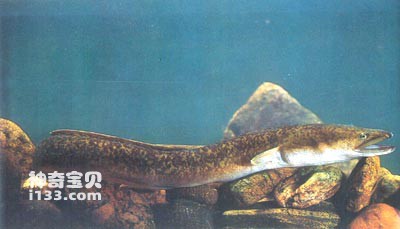Anguilla marmorata (Anguilla marmorata) belongs to the order Anguilla, family Anguilla, and genus Anguilla. Common names: perch eel, flower eel, snow eel, king eel, black ear eel, reed eel, creek eel. English name: Marbled eel.
Endangerment level: Endangered. China's national level II protected wildlife.
The body shape of the flower eel is similar to that of an eel, with a long body, a thick cylindrical front part, and a flattened tail laterally. The head is conical, and the distance between the starting points of the back and anal fins is shorter. The kiss is flat. The corner of the mouth extends beyond the back edge of the eye. The lower jaw is slightly protruding, with no teeth in the center; the front ends of the two jaws have clusters of fine teeth, and the lateral teeth are in rows. The lip folds are broad and thick. Gill openings are small. The scales are small and arranged in a storied pattern. The scales cross each other vertically and are buried under the skin. The lateral line is complete and the lateral line hole is obvious. The odd fins are interconnected; the dorsal fin is low and long, and its starting point is closer to the gill opening than to the anus. The distance between the starting point of the dorsal fin and the starting point of the anal fin is greater than the head length. Pectoral fin rounded. No pelvic fins. There are 100-110 vertebrae. The dorsal side of the body and fins are covered with brown spots, and the gaps between the body spots and the edges of the pectoral fins are yellow. The ventral side is white or blue-gray, and the rear edges of the dorsal and anal fins are black.

The flower eel is one of the typical river migratory fish. Grows in estuaries, swamps, rivers, lakes, reservoirs, etc. The temperament is fierce, the body is strong and powerful. It hides in caves and rock crevices during the day and goes out at night to prey on fish, shrimps, crabs, frogs and other small animals, as well as the carcasses of large animals that fell into the water. It can forage in wet grasslands outside the water and in bamboo forests and bushes after rain. Its feeding area in the Philippines can reach mountain streams with an altitude of 1523.9 meters. In China, it can reach mountain streams such as Tiantai Mountain, North Yandang Mountain, and South Yandang Mountain in Zhejiang, Changting in the upper reaches of Hanjiang River in Fujian, and Jiangyuan in Changjiang, Hainan Island. The gonads do not develop in rivers and lakes; the gonads do not begin to develop until they migrate down rivers in winter near the mouth of rivers as adults, and then enter the deep sea to reproduce. In Jiulongjiang, Fujian, China, people live in caves in Hexi Zhongying from March to July every year. When the northwest wind blows from October to November, they begin to move to the river mouth and enter the sea to breed. The spawning ground of the flower eel is located approximately in the deep ocean trench between the southern Philippines, eastern Sri Lanka and Papua New Guinea. After reproduction, the parent fish dies, and the eggs hatch in the sea currents. The newly hatched larvae are white, soft fronds. The fronds are carried to the land coast by sea currents and undergo metamorphosis, turning into short round strips of young eels, also known as Thread eels enter freshwater rivers and lakes to feed and grow. In the Dawu River Estuary in Taitung, Taiwan, flower eel fry about 70 mm long can be seen before the Mid-Autumn Festival. Eel seedlings enter the Jiulong River in Fujian Province between March and April.
The flowered eel is distributed in the lower reaches of the Yangtze River and south of the Qiantang River, Lingjiang River, Oujiang River, Minjiang River, Jiulong River, Taiwan to Guangdong, Hainan Island and Guangxi; abroad, it reaches southern Korea and Kishu, Japan, and west East Africa, reaching the Marques Islands in the South Pacific in the east and southern Australia in the south.
The largest individual eel is over 2.3 meters tall and weighs 40-50 kilograms. It is called the King of Eels in Guangdong. The peak fishing season is from April to May and September to October in Jiulongjiang, Fujian. It is generally 700-800 mm long and weighs about 5 kg. Flower eel meat is delicious and nutritious. Its nutritional value is similar to that of Japanese eel, but it is more expensive. It has always been regarded as a top-quality nutritious food. Its meat is sweet and flat in nature and has nourishing and strengthening effects. Folks in Zhejiang and Fujian stew flower eel heads with Ligusticum chuanxiong and eat them together with the soup to treat dizziness and headaches. Use flower eels to cook soup as a nourishing food, which is good for pregnant women and people with physical weakness.
In recent years, due to the serious pollution of rivers by industrial toxic sewage and overfishing, as well as the devastating damage to fish resources caused by poisonous and electro-fishing methods, the construction of dams, reservoirs and hydropower stations have blocked the normal migration channels of eels, etc. , resulting in a sharp decline in the resources of the eel, and its traces are now hard to find.
animal tags:
We created this article in conjunction with AI technology, then made sure it was fact-checked and edited by a Animals Top editor.